
Cyrtostylis reniformis, commonly known as common gnat-orchid, is a species of orchid endemic to eastern Australia. It usually has a single kidney-shaped leaf and a flowering spike with up to eight reddish flowers with a shelf-like labellum.

Genoplesium fimbriatum, commonly known as the fringed midge orchid is a small terrestrial orchid found from southern Queensland to southern New South Wales. It has a single thin leaf and up to thirty green to brownish-green flowers with red stripes and a red-tipped labellum with hairy edges.
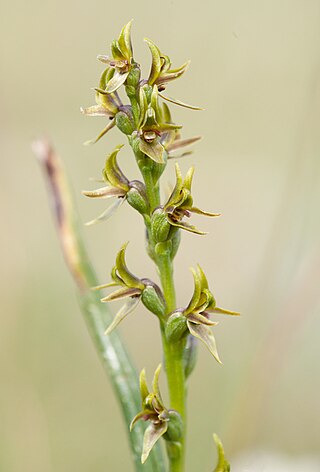
Prasophyllum tadgellianum, commonly known as the alpine leek orchid, is a species of orchid native to the Snowy Mountains and Tasmania. It has a single stiff, erect leaf and up to twenty scented, greenish-brown or reddish-brown flowers crowded on a stout spike.

Caleana major, commonly known as the large duck orchid, is a small orchid found in eastern and southern Australia. This terrestrial plant features a remarkable flower, resembling a duck in flight. The flower is an attractant to insects, such as male sawflies which pollinate the flower in a process known as pseudocopulation. In 1986 this orchid was featured on an Australian postage stamp.

Pterostylis obtusa, commonly known as the blunt-tongue greenhood, is a species of orchid endemic to New South Wales. It is distinguished from similar greenhood orchids by its thick, flat, platform-like sinus and blunt labellum which is only just visible above the sinus.
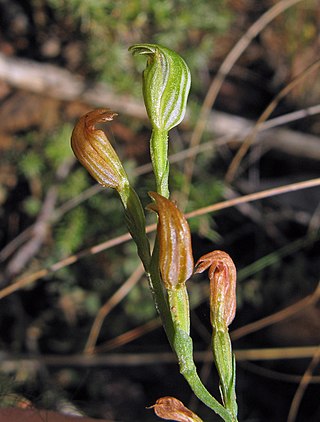
Pterostylis parviflora, commonly known as the tiny greenhood, is a species of orchid endemic to south-eastern Australia. As with similar orchids, the flowering plants differ from those which are not flowering. The non-flowering plants have a rosette of leaves but the flowering plants lack a rosette at the base but have up to eight tiny green, white and brown flowers.

Pterostylis squamata, commonly known as the southern rustyhood or ruddyhood, is a plant in the orchid family Orchidaceae and is endemic to south-eastern Australia. Flowering plants have up to ten translucent green flowers with reddish-brown markings and a hairy, insect-like labellum. Non-flowering plants have a rosette of four to eight egg-shaped leaves. This species is very similar to Pterostylis rufa which has a narrower labellum and other minor differences.
Prasophyllum australe, commonly known as the southern leek orchid or austral leek orchid, is a species of orchid and is endemic to south-eastern Australia. It has a single tubular, green leaf and up to fifty scented, greenish-brown flowers with red stripes.
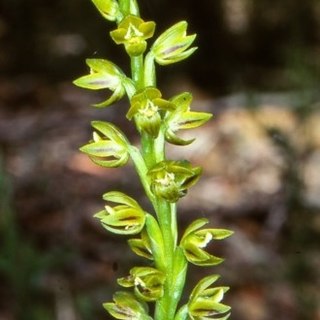
Prasophyllum flavum, commonly known as the yellow leek orchid, is a species of orchid endemic to eastern Australia. It has a single tubular, green leaf with only a short free section and up to fifty scented, yellowish-green flowers.

Prasophyllum fuscum, commonly known as the slaty leek orchid or tawny leek orchid, is a species of orchid endemic to a small region of New South Wales. It has a single tubular green leaf and up to thirty greenish brown to reddish brown flowers. There is debate about the taxonomy of the species with some authorities considering Prasophyllum uroglossum as a separate species. Only about twenty five plants are known to survive in south-western Sydney.
Prasophyllum gibbosum, commonly known as the humped leek orchid, is a species of orchid endemic to the south-west of Western Australia. It is a late-flowering leek orchid with a single smooth, tubular leaf and up to eighty or more purplish-red and white flowers with a smooth labellum. It is similar to P. cucullatum but that species has a frilly labellum, usually a shorter flowering stem and an earlier flowering period.
Prasophyllum macrostachyum, commonly known as the laughing leek orchid, is a species of orchid endemic to the south-west of Western Australia. It has a single smooth, tube-shaped leaf and up to thirty yellowish-green and purple flowers. It is one of the few Western Australian leek orchids which is not stimulated by summer fires and also has an unusually long flowering period.

Acianthus caudatus, commonly known as mayfly orchid, is a species of flowering plant in the orchid family Orchidaceae and is endemic to eastern Australia. It is a terrestrial herb with a single egg-shaped or heart-shaped leaf and up to nine dark purplish flowers with thin, spreading sepals and petals, often with a musty odour.

Prasophyllum patens, commonly known as the broad-lipped leek orchid or sandstone leek orchid, is a species of orchid endemic to the Sydney region of New South Wales. It has a single tubular green leaf and up to thirty green to greenish-brown, lemon-scented flowers with a white labellum.

Prasophyllum striatum, commonly known as the streaked leek orchid, is a species of orchid endemic to New South Wales. It has a single thin, tube-shaped leaf and up to ten greenish and whitish flowers with reddish or purplish stripes. It differs from other leek orchids in having a very thin leaf and prominently streaked flowers.
Genoplesium rufum, commonly known as the rufous midge-orchid, is a species of orchid endemic to New South Wales. It has a single thin, wiry leaf and up to twenty five drooping, pinkish or reddish flowers on a flowering stem which is fused to the lower part of the leaf. It was formerly thought to range from Queensland to South Australia and Tasmania but specimens in other states are now assigned to Genoplesium clivicola.
Genoplesium baueri, commonly known as the brittle midge orchid, is a small terrestrial orchid which is endemic to New South Wales. It has a single thin leaf and up to nine yellowish green to reddish brown flowers. It is mostly only found in coastal and near-coastal heath and woodland between Port Stephens and Ulladulla.

Corybas fimbriatus, commonly known as the fringed helmet orchid, is a species of terrestrial orchid endemic to eastern Australia. It has a broad egg-shaped to round leaf and a dark reddish purple to crimson flower with translucent patches. It is similar to C. hispidus but its labellum lacks a creamy-white centre and is not covered with bristly hairs.
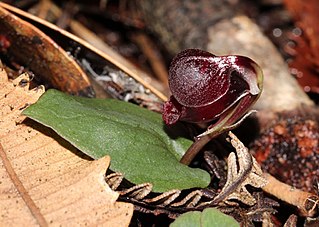
Corybas unguiculatus, commonly known as the small helmet orchid or pelicans, is a species of terrestrial orchid endemic to south-eastern Australia. It is a widespread, sometimes common but small orchid with a single leaf and a single reddish purple to reddish black flower.
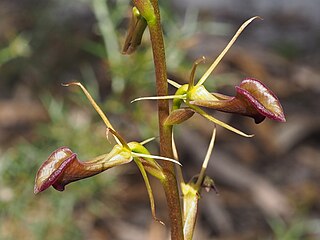
Cryptostylis ovata, commonly known as slipper orchid or western tongue orchid, is an orchid endemic to Western Australia. It is a common, summer flowering species with dark green leaves with a white central vein and up to fifteen pale greenish flowers with a brownish red labellum with a network of darker veins.















